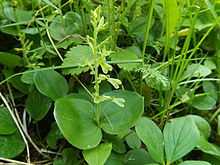Neottia convallarioides
| broad-lipped twayblade broad-leaved twayblade | |
|---|---|
 | |
| Scientific classification | |
| Kingdom: | Plantae |
| (unranked): | Angiosperms |
| (unranked): | Monocots |
| Order: | Asparagales |
| Family: | Orchidaceae |
| Subfamily: | Epidendroideae |
| Genus: | Neottia |
| Species: | N. convallarioides |
| Binomial name | |
| Neottia convallarioides (Sw.) Rich.[1] | |
| Synonyms[1] | |
| |
Neottia convallarioides is a species of orchid known by the common names broad-lipped twayblade and broad-leaved twayblade. It was formerly placed in the genus Listera, but molecular phylogenetic studies have shown that Neottia nidus-avis, the bird's-nest orchid, evolved within the same group,[2] and all species of Listera have been moved to Neottia.[3]
Neottia convallarioides is native to much of Canada and in parts of the United States (Alaska, the Great Lakes Region, New England, and the mountains of the West: Rockies, Cascades, Sierra Nevada, etc.). I also reportedly occurs in St. Pierre & Miquelon and on the Komandor Islands in the Bering Sea, part of the Russian Far East.[1][4][5]
Neottia convallarioides is a plant of cool, moist, dim habitat, such as woods and forest, as well as swamps and streambanks. It is a rhizomatous perennial herb growing erect 10 to 35 centimeters tall. It has one pair of green oval leaves each up to 7 centimeters long near the base of the stem. The inflorescence is a small raceme of green or yellow-green flowers, sometimes slightly purple-tinged. Each has usually 3 reflexed lance-shaped sepals, 2 similar petals, and one petal known as the lip, which is longer, wedge-shaped, and notched at the tip. The plant sometimes forms large colonies, creating a groundcover.[6] It is known to hybridize with Neottia auriculata.[6]
References
- ↑ 1.0 1.1 1.2 "Neottia convallarioides", World Checklist of Selected Plant Families, Royal Botanic Gardens, Kew, retrieved 2012-04-04
- ↑ Stace, Clive (2010), New Flora of the British Isles (3rd ed.), Cambridge, UK: Cambridge University Press, ISBN 978-0-521-70772-5, p. 864
- ↑ "Listera", World Checklist of Selected Plant Families, Royal Botanic Gardens, Kew, retrieved 2012-04-04
- ↑ Flora of North America v 26 p 590, Broad-leaved twayblade, Listera convallarioides (Swartz) Nuttall ex Elliott, Sketch Bot. S. Carolina. 2: 494. 1823.
- ↑ Biota of North America Program, 2013 county distribution map, Neottia convallarioides
- ↑ 6.0 6.1 Hoy, J. (2002). Conservation Assessment for Broad-leaved Twayblade (Listera convallarioides). USDA. White Mountain National Forest.